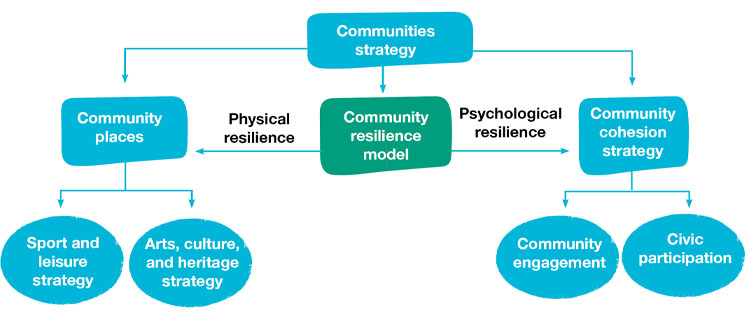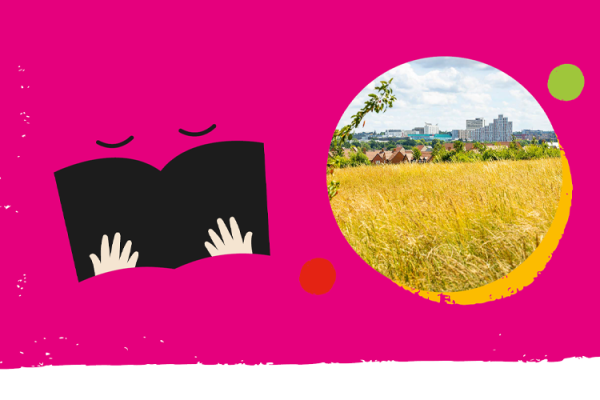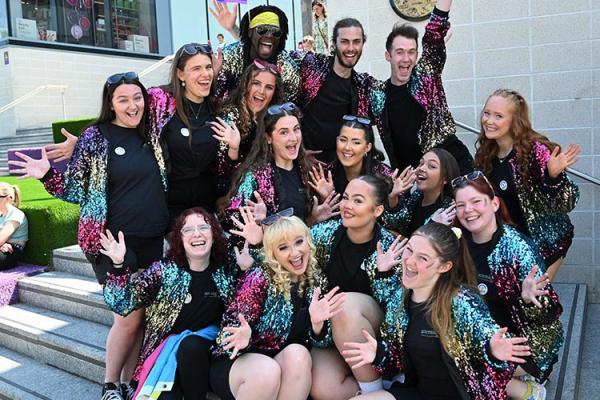Enhance the diversity and vibrancy of Bracknell Forest through creative opportunities, connecting communities and pride in place.
This will enhance community spirit and boost the local economy for visitors, businesses, and residents.

This document identifies a vision for the development of arts, culture and heritage in Bracknell Forest. It will extend the focus in this area of work, to recognise the value that arts, culture and heritage can offer. This is not aiming to be as extensive as a strategy as the development has been relatively light touch during the period where a new Communities Strategy is being explored.
Arts, culture, and heritage features across a variety of council services, and the role of partners in creating this rich environment is vital. Therefore, taking a partnership approach is the longer-term ambition for this work. The voluntary, community and faith sector, and town and parish councils will all be critical to developing the future of arts, culture, and heritage, as well as partnerships with the business community and other public sector partners including health, schools and housing associations. Refreshing and expanding this framework to create a comprehensive strategy will be possible following the adoption of the Communities strategy. In the meantime, the council will continue to progress with opportunities for expanding and sustaining arts, culture and heritage, working with partners.
Arts, culture, and heritage each have broad definitions and can include a huge range of activities, places and personal feelings.
The arts include different expressions, such as visual arts, music, theatre, and literature, offering opportunities for both residents and visitors to engage creativity. For residents, the arts can foster personal growth, wellbeing, and community connection, while visitors to the borough can experience the local character and story through its artistic activities.
Culture refers to the shared values, traditions, and practices that shape a community’s identity, from customs and festivals to language and cuisine. Culture provides a sense of belonging and unity among communities, it can be a key part of developing ‘pride in place’.
Heritage includes physical assets such as historic buildings and gardens but also intangible things like traditions, artefacts, and local knowledge. Preserving heritage helps maintain a borough’s historical continuity and educates both residents and visitors about its past.

Arts, heritage and culture could be overlooked in local government as it is not a statutory service. Particularly as resources continue to become more limited, there are fewer financial opportunities to invest in this area. However, there is growing recognition of the value that can be generated through arts, culture and heritage. This includes working towards core council priorities such as enhancing Engaged and healthy communities and facilitating a Thriving and connected economy.
Cultural facilities, activities and events can entice more local investment, with increased visitors to the borough and more people spending. This supports the local economy and could offer further growth opportunities.
Strengthening the local arts, culture and heritage offer can also develop the cohesion and connections in the local community. The promotion of arts and culture encourages inclusion and diversity, often showing different perspectives and bringing people together from a range of backgrounds. This can strengthen community resilience and offers a foundation for local people supporting each other directly. Further benefits include reduced health and care risks like social isolation and mental ill health. Ultimately this can reduce the need for public sector intervention, acting as early prevention.
Where funding is highly limited, this framework will help to prioritise and focus where existing resources can have the greatest impact for the borough. Arts, culture, and heritage reach across many council services, from libraries, to economic development (town centre events), to grounds maintenance (for example, underpass murals). Therefore, a strategy would provide the opportunity to better connect and coordinate these efforts to amplify the impact. Longer term, the strategy would also
seek to encompass the wider partner and community activity related to the arts.
Engagement activity in 2023 to explore opportunities for the borough, residents and partners supported with identifying a vision. This has been refreshed to bring it up to date.
Our vision is for the arts, culture, and heritage framework to:
Enhance the diversity and vibrancy of Bracknell Forest through creative opportunities, connecting communities and pride in place.
This will enhance community spirit and boost the local economy for visitors, businesses, and residents.
Today, Bracknell Forest attracts many families and visitors, its green spaces and connectivity, together with strong sport, leisure, and retail offers, make it an appealing area to settle and form close knit communities.
Covering 39% of the borough, forests and woodlands are key to the borough’s identity and a source of pride for residents. The connection to nature, combined with its proximity to London and strong business base have all contributed to making Bracknell Forest an attractive place to live and work. Though well known for its quality business and employment opportunities, the borough has a committed and thriving cultural scene centred around the borough’s flagship culture venue at South
Hill Park. The Lexicon also hosts regular events throughout the year, whilst smaller independent arts, heritage and cultural offers are scattered throughout the borough, often within local community centres and libraries.
The arts are also increasingly linked to economic development and business with an emerging creative industry locally focused on TV and film. Therefore, there are increasing employment opportunities for residents to apply the arts in their work. This may over time, attract more local people who have an interest in arts and culture. Heritage highlights include the Iron Age hill fort in Swinley Forest, Caesar’s Camp and the Royal Military College in Sandhurst. There is also the legacy of the New Town developments in Bracknell, with many original neighbourhoods still thriving communities.
There are distinct identities across the borough with the rural feel of the villages in the north and the ‘fields’, and historic town in the south of Sandhurst and Crowthorne village. Centrally located in the borough is Bracknell Town, a historic market town which also has its heritage in the New Town movement in the 1960s. Bracknell has distinct neighbourhoods each having local facilities clustered in a neighbourhood centre supporting community connectedness. The nearest university is located approximately 10 miles away, meaning there is a smaller proportion of 20 to 24-year-olds than the national average. This is also relevant in the context of night time culture and amateur and social arts.
Overall, the borough is still growing and at a faster rate than the South East and England, over 124,000 people now live here. There is a smaller proportion of older people compared to the national average, meaning there are more families and working age households. Most residents live a healthy life and there is relatively low deprivation, disposable income is higher than average. There are some continuing health challenges related to mental health and obesity. There is increasing diversity in the borough with more people from different ethnic backgrounds.
This all creates a local identity within the borough and highlights opportunities for the area. As the borough is continuing to grow and diversify, the role of arts, culture and heritage becomes more important. Specifically, consideration should be made around the capacity and infrastructure of arts, culture and heritage to meet this increasing population demand. This will require further exploration of local demand.
The council has set out a number of ambitions in the Council Plan, this includes the goal for ‘community development and facilities to encourage cohesive and engaged communities’. Developing arts, culture and heritage initiatives provides further opportunities to achieve this goal. Also within the Council Plan is the priority for a thriving and connected economy, this recognises the importance of the town centre, neighbourhood and village centres as hubs of community activity, which the arts would encourage.
A Communities Strategy is in early development, and this will provide a framework for how communities in Bracknell Forest can strengthen and develop resilience. Key themes around the role of the council and partners in working with residents will be explored along with identifying opportunities to enhance community connections. Longer term the arts, culture and heritage strategy will integrate with the communities strategy by establishing the targeted ways that this can further enhance the communities’ ambitions. Therefore, this current framework bridges the period until the goals of the communities strategy are agreed.
The diagram below sets out how the arts, culture and heritage strategy is one part of developing resilient communities and contributing to the goals to a new communities strategy. It will sit alongside wider ambitions such as for sports and leisure, and community cohesion. Beyond this, there are links to ambitions in the economic strategy where arts, culture and heritage can enhance the local area, making an attractive place for employers and supporting the local economic centres.

In 2023, work was commissioned to seek local insight into the opportunities to enhance arts, culture and heritage in the borough. This research identified several strengths in the current offer such the importance of South Hill Park as an arts venue, and local accessible facilities such as a comprehensive network of libraries, the Bracknell leisure centre, and the cinema. There was also positive feedback around the range of town centre events that are hosted.
Local people felt pride in the green spaces and wildlife, and particularly how easy these are to access. Several respondents highlighted strengths in community connectedness, which suggests a good foundation to further build on.
Opportunities to further improve the local offer were linked to seeking more entertainment and music events and clearer publication of events and activities such as through a ‘what’s on’ directory. Some reported looking for more activities for young people and more public art, particularly in connected trails and walks. As well as recognition and a desire to share Bracknell Forest’s heritage.
The work conducted in 2023 highlighted the extensive ‘art of the possible’ across the borough. The challenge is now around focusing and prioritising the resources to opportunities with the greatest impact for the community, in line with the vision.
Within this current framework, 4 themes of activity are proposed that address the opportunities identified in previous research and balance this with where the council can have the greatest impact.
A fifth theme will focus on possible income streams such as section 106 funding and the community infrastructure levy (CIL).
Woven across these themes will be the 2 core aims from the vision, to enhance community cohesion and pride in place, and deliver economic benefits.
This framework does not seek to develop a full action plan or detailed goals, but it focuses on recognising and coordinating activity over the next two years until the wider communities’ strategy is developed. Therefore, the scope of the priorities primarily focuses on those within the council’s influence.

Bracknell Forest libraries runs nine sites across the borough, with the central library located in Bracknell Town Centre. This is the largest site with the library stock arranged over 2 floors with 2 generous supplementary spaces on the lower ground floor used for events, meetings, community workshops and classes.
Crowthorne library also has space that can be used for community activities, and Binfield Library is regularly used for councillor surgeries. The library service provides a range of activities and events for the community including digital access to support digital inclusion.
A new service structure of Customer and Library Services will start implementation from February 2025, focusing on customer interactions to act as a “physical front door” for the council. This will complement remote and digital service channels, foster social connections and inclusivity, access to community library resources and lay a foundation for exploring future opportunities for arts, culture and heritage.
There is further potential for libraries to shift to broader community participative spaces. To reach this, further exploration will be needed to make sure that the spaces are fit for a range of activities. An assessment of spaces would support in mapping how more arts, culture and heritage activities could be hosted in these spaces to build strong and connected communities.
The Lexicon shopping centre in Bracknell provides a high-quality shopping and leisure environment. The Lexicon and the council host events throughout the year. These are spread between the indoor atrium of Princess Square and the outdoor performance space of Bond Square. Events have proven extremely popular with the public with highlights including the Forest Giants, Pride and the culture and community day. There was also collaboration with South Hill Park in the summer 2023, to deliver the ‘Follow the Yellow Brick Road: A Wizard of Oz Experience’, with the cast leading the audience on a route between the arts venue and the town centre.
There are a wide range of public art sculptures and artwork located in underpasses, near the train station and some of the original New Town works affixed to Braccan Walk carpark. However, the council’s public art strategy was most recently revised in 2013, so it not currently up to date with the range of public art locally.
Opportunities for future development include the former Bentall’s site and the areas identified in the adopted masterplans for the southern and eastern gateways. With the closure of the High Street car park, this offers another potential development site. It is also important to recognise the continuous change in the demand for retail and leisure provision and the gradual transition to a more diverse economy associated with an increasing residential population. These new spaces offer the opportunity to explore how arts, culture and heritage could be further extended in the town centre.
Developing arts, culture and heritage also aligns with the work of the Berkshire Prosperity Board, particularly related to the development of a pan-Berkshire local visitor economic partnership. This recognises the importance of attracting and retaining the value of the wider visitor economy. Building on the success of the collaboration between the council and The Lexicon, a programme of events is continually being developed each year. The focus will move towards local community activity and delivered with support from the council.
South Hill Park is the arts centre for Bracknell Forest and well recognised across Berkshire and beyond. It is a key heritage building and is managed by the South Hill Park Arts Trust. In addition to ticketed shows, it offers a varied range of access into the arts, from courses and workshops to events, volunteering and summer programmes.
The centre offers high quality provision of arts and culture, across a range of disciplines including theatre, music, performance, ceramics, printmaking, film and festivals and events and is the home of Artemis Arts College, which provides a range of performing arts courses for young people. There is a broad appeal to different age groups and abilities, with dementia friendly screenings and inclusive activities tailored to children, young people, and adults of all abilities.
The financial sustainability of South Hill Park (and many other arts venues nationally) is becoming increasingly challenging, especially in relation to capital needs and rising costs to maintain such a large heritage site. Activity is based on relatively short-term grant funding alongside generated income from arts and commercial activity. The role of alternative funding streams through partnership working with a diverse range of partners is becoming more important.
However there remain high ambitions for arts, culture and heritage. The continuation in 2025 of key local events such as Wilde Week and the food and music festival will be explored as part of further national grant funding. Beyond this, there are opportunities to extend outreach work across the borough and invest in onsite facilities. Creating a long-term vision and goal for these will be key to explore over the next 12 to 18 months.
Within the borough there are 6 town and parish councils, Binfield parish, Bracknell town, Crowthorne parish, Sandhurst town, Warfield parish and Winkfield parish.
Each has a key role in fostering community engagement and enhancing local identity. They all host various initiatives and events across the year, and undertake work related to public art and heritage conservation. Examples include the Northern Parishes Arts Week, next planned for Autumn 2025. These councils
also provide funding and support for local arts and cultural activities.
By working closely with residents and the borough council, town and parish councils are helping create vibrant and cohesive communities. Further connecting the resources across these partners and aligning local knowledge and experience could be further explored in the coming years.
Beyond these core themes, there are also emerging opportunities relating to design and heritage with the recent appointment of an Urban Design and Heritage Officer. This appointment provides an opportunity to consider identifying a new Conservation Area in the Church Lane area of Binfield and to consider the preparation of design codes in light of new Government advice. Existing work continues to recognise buildings of interest through the ‘Local List’ of buildings of historic interest and the determination of planning and listed building applications in accordance with national and local planning policies continues to protect valued heritage assets. This will support in protecting and ensuring the high quality of listed and locally sensitive buildings.
There are also existing community groups that are active in developing arts, culture and heritage initiatives in the borough. For example, the Bracknell Forest Society are an independent local voice safeguarding heritage, environment, community and future development. The group is run by volunteers who host a wide range of events through the year to preserve and communicate the local history. There could be further opportunities to connect and work with these existing groups to understand their skills, experience and future plans.
Economically, there is also increasing creative industries locally, particularly related to film and TV. Fostering talent in the arts offers further opportunities to enhance skills of local people to support the sector to thrive and grow further.

Since 2022, the UK Shared Prosperity Fund (UKSPF), has offered local areas the opportunity to invest in skills, employment, developing communities and pride in place. The funding is set to continue in 2025 to 2026. However the future beyond this is uncertain. Over the next 12 to 18 months, it provides an opportunity to further
develop local initiatives.
There are several aims of the fund that specifically relate to arts, culture and heritage including:
For 2025 to 2026, Bracknell Forest will receive a grant of £327,146. Specifically, at least £60,401 must be used for capital work and the remaining for revenue costs. The interventions have been amended for 2025 to 2026, therefore activity must be mapped against 5 UK-wide themes and 12 sub-themes that are focused explicitly on delivering the government’s Missions. However broadly, the ambitions and intentions of the grant remain the same.
Under the Communities and Place priority of the UKSPF, arts, culture and heritage is relevant to the following themes:
Therefore, part of this action plan will seek to identify possible local investment for the UKSPF to enhance the arts, culture and heritage offer. There will also be wider requests for us of the UKSPF, so the details of the use for 2025 to 2026 will be agreed in the coming months.
Section 106 funding is another key opportunity to direct funding to arts, culture and heritage. The money is gathered through the delivery of new developments, where developers contribute towards specific projects related to community infrastructure, affordable housing, highways, open space and other environmental requirements. This funding can then be used to enhance the capacity and quality of local community facilities.
Generally, the use category is earmarked as part of the planning consent stage. Therefore, the majority of existing section 106 funding from known developments will be used towards specific projects. However, the council are increasingly seeking to gather section 106 funding for arts, culture and heritage projects. This means that funding will not yet be available, however there will be a pipeline of potential funding in the coming years depending on projects being developed.
The Community Infrastructure Levy (CIL) may also provide a source of funding; however, CIL is pooled with other council funding towards priority projects. Therefore, to access CIL (and/or) other funds, a project proposal (called a PAD) must be put forward. This is carried out on an annual basis as part of the budget setting cycle.
An important part of this framework is to inform the emerging communities strategy as arts, culture and heritage are opportunities to develop the spaces in the borough and foster a resilient community.
Over the course of the next 12 months, the insights and understanding gathered from the development of the communities strategy will offer further learning to review the arts, culture and heritage strategy. Ultimately the aim is to develop a full strategy to replace this document in 2026 to 2027.
In the meantime, activity will continue to build on the arts, culture and heritage landscape for the borough. Through exploring the key service areas of libraries, town centre and South Hill Park, the following areas will be a continued focus for arts, culture and heritage:
There may also be opportunities in the coming 24 months for further physical infrastructure investment as part of funding received, such as UKSPF and Section 106, and wider partnership working. Therefore, a series of investment opportunities have also been identified that could be further explored, should funding become available.
The most recent position for the use of Section106 and CIL funding is available in the annual Infrastructure Funding Statement. These would each help enhance the delivery of arts, culture and heritage in the borough.
Explore opportunity for new culture, heritage and arts spaces, exhibition space, small theatre and creative industries space.
Redevelopment of multifunctional library and community space.
Enhancing the ‘Forest’ identity and branding - including the scope to introduce open spaces within the town centre.
Assessment and re-development of further spaces/sites to be multi-functional community spaces including adding capacity at these sites.
Site investment opportunities to explore for feasibility and costs such as amphitheatre shelter, additional storage space on site, increasing Wilde theatre capacity by around 70 seats.
Expanding the borough wide community outreach and equality, diversity and inclusion offer.
Updating and re-developing the public art strategy and local heritage offer
It will be important to continue to assess the additional requirements, opportunities and vision for arts, culture and heritage in the borough to meet increasing population diversity and growth. This will be a priority in developing the detailed arts, culture and heritage strategy in the coming years.